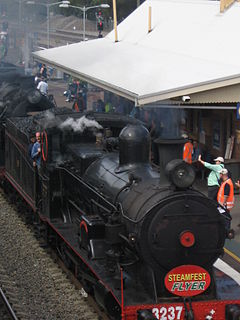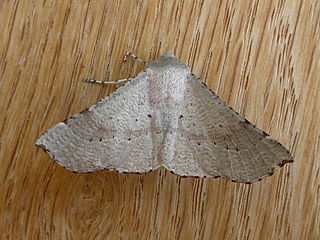
Biological control or biocontrol is a method of controlling pests such as insects, mites, weeds and plant diseases using other organisms. It relies on predation, parasitism, herbivory, or other natural mechanisms, but typically also involves an active human management role. It can be an important component of integrated pest management (IPM) programs.

The de Havilland DH.82 Tiger Moth is a 1930s British biplane designed by Geoffrey de Havilland and built by the de Havilland Aircraft Company. It was operated by the Royal Air Force (RAF) and many other operators as a primary trainer aircraft. In addition to the type's principal use for ab-initio training, the Second World War saw RAF Tiger Moths operating in other capacities, including maritime surveillance and defensive anti-invasion preparations; some aircraft were even outfitted to function as armed light bombers.

Australia, officially the Commonwealth of Australia, is a sovereign country comprising the mainland of the Australian continent, the island of Tasmania, and numerous smaller islands. It is the largest country in Oceania and the world's sixth-largest country. Australia's population of nearly 26 million, in an area of 7,617,930 square kilometres (2,941,300 sq mi), is highly urbanised and heavily concentrated on the eastern seaboard. Canberra is the nation's capital, while the largest city is Sydney, and other major metropolitan areas are Melbourne, Brisbane, Perth, and Adelaide.

No. 35 Squadron is a Royal Australian Air Force (RAAF) transport unit. Formed in 1942, No. 35 Squadron operated during World War II, transporting cargo and passengers around Australia, New Guinea and the Netherlands East Indies, equipped with a variety of aircraft including the Douglas Dakota. It was disbanded after the war, but was re-raised in the 1960s for service during the Vietnam War, flying transportation and resupply operations with DHC-4 Caribous in support of Australian and US forces. The squadron was subsequently augmented with rotary-wing aircraft, operating UH-1 Iroquois in both the transportation and gunship roles. In the late 1980s, the squadron returned to a solely fixed-wing transport role. It ceased operations in 2000, but was re-raised in January 2013. It began re-equipping with C-27 Spartan transports in 2015.

Nepticulidae is a family of very small moths with a worldwide distribution. They are characterised by eyecaps over the eyes. These pigmy moths or midget moths, as they are commonly known, include the smallest of all living moths, with a wingspan that can be as little as 3 mm in the case of the European pigmy sorrel moth, but more usually 3.5–10 mm. The wings of adult moths are narrow and lanceolate, sometimes with metallic markings, and with the venation very simplified compared to most other moths.

The Adelidae or fairy longhorn moths are a family of monotrysian moths in the lepidopteran infraorder Heteroneura. The family was first described by Charles Théophile Bruand d'Uzelle in 1851. Most species have at least partially metallic patterns coloration and are diurnal, sometimes swarming around the tips of branches with an undulating flight. Others are crepuscular and have a drab coloration. Fairy longhorn moths have a wingspan of 4–28 millimeters, and males often have especially long antennae, 1–3 times as long as the forewing.

The de Havilland DH.94 Moth Minor was a 1930s British two-seat tourer/trainer aircraft built by de Havilland at Hatfield Aerodrome, England, and by de Havilland Australia at Bankstown Aerodrome, Australia.

Utetheisa pulchelloides, the heliotrope moth, is a moth of the family Erebidae. It is found in the Indo-Australian region including Borneo, Hong Kong, New Zealand, Papua, Seychelles and most of Australia. The species was first described by George Hampson in 1907.

Netrocoryne repanda, the bronze flat, eastern bronze flat, or eastern flat, is a butterfly found in Australia, belonging to the subfamily Pyrginae of the family Hesperiidae.

Oenochroma vetustaria, the ribbed wine moth, is a species of moth of the family Geometridae. It is found in South Eastern Australia.

Niceteria is a monotypic moth genus in the family Geometridae erected by Alfred Jefferis Turner in 1929. Its only species, Niceteria macrocosma, the showy geometrid, is found in Australia. It was first described by Oswald Bertram Lower in 1899.

Oenochroma is a genus of moths in the family Geometridae erected by Achille Guenée in 1857.

The Hunter Valley Steamfest is one of the major events in the New South Wales steam locomotive season and also one of the major events held in Maitland, in the Hunter Region. Held over two days in April, it is usually attended by steam locomotives from the Canberra Railway Museum, NSW Rail Museum and Powerhouse Museum and railmotors from the Rail Motor Society.

Charles Eaton, OBE, AFC was a senior officer and aviator in the Royal Australian Air Force (RAAF), and later served as a diplomat. Born in London, he joined the British Army upon the outbreak of World War I and saw action on the Western Front before transferring to the Royal Flying Corps in 1917. Posted as a bomber pilot to No. 206 Squadron, he was twice captured by German forces, and twice escaped. Eaton left the military in 1920 and worked in India until moving to Australia in 1923. Two years later he joined the RAAF, serving initially as an instructor at No. 1 Flying Training School. Between 1929 and 1931, he was chosen to lead three expeditions to search for lost aircraft in Central Australia, gaining national attention and earning the Air Force Cross for his "zeal and devotion to duty".

Opogona stereodyta is a moth of the family Tineidae. It is found in southern Australia.
Nokona coracodes is a moth of the family Sesiidae. It is only known from Toowoomba, Queensland.

Oenochrominae is a subfamily of the moth family Geometridae.

Spodoptera mauritia, the lawn armyworm or paddy swarming caterpillar, is a moth of the family Noctuidae. The species was first described by Jean Baptiste Boisduval in 1833. Able to eat many types of food, it is a major pest throughout the world.

Peter Burling is a New Zealand sailor. He was the 2021 America's Cup winning skipper and helmsman, and the 2017 America's Cup winning helmsman of Team New Zealand, and was an Olympic silver and gold medalist in the 49er class at the 2012 and 2016 games, respectively.

Oenochroma privata is a moth of the family Geometridae first described by Francis Walker in 1860. It is known from Australia.



















